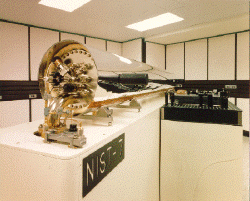Juggling Atoms

A juggler needs precise timing, but some precision clock experts say that in the future, precise timing may rely on juggling. Tossing up ultracold balls of atoms consecutively should allow extremely precise measurement of atomic transition frequencies–the basis for the world time standards. A report in the 28 December PRL describes the first example of such a “juggling atomic fountain,” where two clouds of atoms are consecutively launched upwards with carefully controlled velocities. The system may represent an advance toward better clocks, but the authors use it to perform low-speed atomic collision experiments with unprecedented sensitivity, which should allow them to probe new details of atomic interactions.
The ideal scattering experiment begins with two atoms or nuclei with carefully prepared speeds and directions and ends with the measurement of those quantities after the particles have collided. But groups of extremely cold, slow moving atoms are difficult to corral into clouds with uniform velocities–instead, they are usually cooled with a broad distribution of velocities. Researchers are eager to study scattering at temperatures close to absolute zero because quantum mechanics reigns in that regime, where collisions between atoms are best described as wavelike interactions, rather than as billiard ball bounces. For example, when two ultracold atoms collide, the scattering pattern goes out isotropically in all directions, in the same way that light shined on a very small hole spreads out in all directions beyond it. A slow collision like that is called ” s wave” and has zero angular momentum ( l = 0).
Three years ago Kurt Gibble and his colleagues at Yale University observed the spherically symmetric pattern using the first method for angular resolution of low temperature atomic scattering [Phys. Rev. Lett. 75, 2666 (1995)]. Now they have improved on that method and seen the changes in scattering as the collision energy is increased beyond the s-wave level. The team’s previous work involved cooling a single cloud of cesium atoms to about 1 µK, launching it upward to a height of several centimeters, and then measuring the changes in the distribution of velocities when the cloud returned. The point of tossing atoms this way is to allow sufficient time for the atoms to interact while not under the influence of any laser beams.
A simple fountain does not work as well at higher collision energies, so Gibble and Yale colleague Ronald Legere created the juggling fountain. In this experiment they tossed up a second ball of atoms as little as 7 ms after the first one, so that the two collided near the top of their trajectories at a relative speed determined by the delay. The team used an arsenal of lasers to manipulate the atoms and inspect the velocities in the second ball upon its return. Other cold atom scattering techniques do not allow this degree of control over the pre-collision velocity or the ability to measure the angles at which atoms emerge from collisions. “You can do a perfect scattering experiment,” says Gibble.
Using the angular data, Legere and Gibble detected both s- and p-wave( l = 0 and l = 1) scattering patterns independently and saw the wavelike interference of the two. They even found a collision energy where all of the s waves cancel so that the clouds of atoms hardly scatter at all, but pass right through one another–a wave phenomenon familiar to anyone with anti-reflection coated eye glasses. Gibble says this energy would be ideal for operating a juggling fountain atomic clock because many balls of atoms could be juggled, with collisions having little affect on the atomic transition frequencies the clock measures. The advantage of juggling atoms in an atomic clock is that more atoms could be measured in a given amount of time than is possible with conventional atomic clocks.


